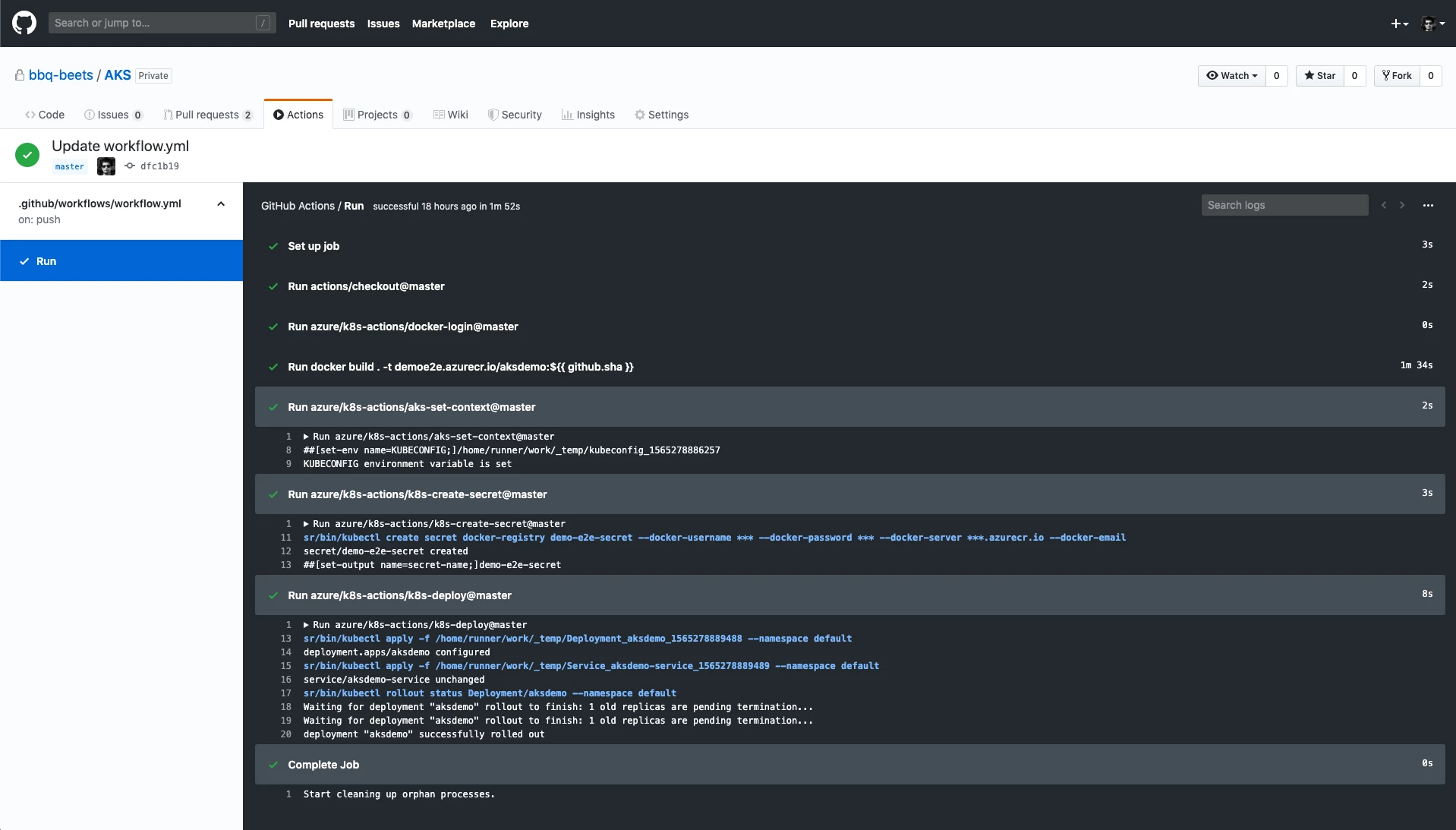October 15, 2019 update: Please note that some of the Actions mentioned below have been moved to new GitHub repositories during the preview. Please refer to the Azure/actions GitHub repository for updated instructions.
On Thursday, August 8, 2019, GitHub announced the preview of GitHub Actions with support for Continuous Integration and Continuous Delivery (CI/CD). Actions makes it possible to create simple, yet powerful pipelines and automate software compilation and delivery. Today, we are announcing the preview of GitHub Actions for Azure.
With these new Actions, developers can quickly build, test, and deploy code from GitHub repositories to the cloud with Azure.
You can find our first set of Actions grouped into four repositories on GitHub, each one containing documentation and examples to help you use GitHub for CI/CD and deploy your apps to Azure.
- azure/actions (login): Authenticate with an Azure subscription.
- azure/appservice-actions: Deploy apps to Azure App Services using the features Web Apps and Web Apps for Containers.
- azure/container-actions: Connect to container registries, including Docker Hub and Azure Container Registry, as well as build and push container images.
- azure/k8s-actions: Connect and deploy to a Kubernetes cluster, including Azure Kubernetes Service (AKS).
Connect to Azure
The login action (azure/actions) allows you to securely connect to an Azure subscription.
The process requires using a service principal, which can be generated using the Azure CLI, as per instructions. Use the GitHub Actions’ built-in secret store for safely storing the output of this command.
If your workflow involves containers, you can also use the azure/k8s-actions/docker-login and azure/container-actions/aks-set-context Actions for connecting to Azure services like Container Registry and AKS respectively.
These Actions help setting the context for the rest of the workflow. For example, once you have used azure/container-actions/docker-login, the next set of Actions in the workflow can perform tasks such as building, tagging, and pushing container images to Container Registry.
Deploy a web app
Azure App Service is a managed platform for deploying and scaling web applications. You can easily deploy your web app to Azure App Service with the azure/appservice-actions/webapp and azure/appservice-actions/webapp-container Actions.
The azure/appservice-actions/webapp action takes the app name and the path to an archive (*.zip, *.war, *.jar) or folder to deploy.
The azure/appservice-actions/webapp-container supports deploying containerized apps, including multi-container ones. When combined with azure/container-actions/docker-login, you can create a complete workflow which builds a container image, pushes it to Container Registry and then deploys it to Web Apps for Containers.
Deploy to Kubernetes
azure/k8s-actions/k8s-deploy helps you connect to a Kubernetes cluster, bake and deploy manifests, substitute artifacts, check rollout status, and handle secrets within AKS.
The azure/k8s-actions/k8s-create-secret action takes care of creating Kubernetes secret objects, which help you manage sensitive information such as passwords and API tokens. These notably include the Docker-registry secret, which is used by AKS itself to pull a private image from a registry. This action makes it possible to populate the Kubernetes cluster with values from the GitHub Actions’ built-in secret store.
Our container-centric Actions, including those for Kubernetes and for interacting with a Docker registry, aren’t specific to Azure, and can be used with any Kubernetes cluster, including self-hosted ones, running on-premises or on other clouds, as well as any Docker registry.

Full example
Here is an example of an end-to-end workflow which builds a container image, pushes it to Container Registry and then deploys to an AKS cluster by using manifest files.
on: [push]
jobs:
build:
runs-on: ubuntu-latest
steps:
- uses: actions/checkout@master
- uses: azure/container-actions/docker-login@master
with:
login-server: contoso.azurecr.io
username: ${{ secrets.REGISTRY_USERNAME }}
password: ${{ secrets.REGISTRY_PASSWORD }}
- run: |
docker build . -t contoso.azurecr.io/k8sdemo:${{ github.sha }}
docker push contoso.azurecr.io/k8sdemo:${{ github.sha }}
# Set the target AKS cluster.
- uses: azure/k8s-actions/aks-set-context@master
with:
creds: '${{ secrets.AZURE_CREDENTIALS }}'
cluster-name: contoso
resource-group: contoso-rg
- uses: azure/k8s-actions/k8s-create-secret@master
with:
container-registry-url: contoso.azurecr.io
container-registry-username: ${{ secrets.REGISTRY_USERNAME }}
container-registry-password: ${{ secrets.REGISTRY_PASSWORD }}
secret-name: demo-k8s-secret
- uses: azure/k8s-actions/k8s-deploy@master
with:
manifests: |
manifests/deployment.yml
manifests/service.yml
images: |
demo.azurecr.io/k8sdemo:${{ github.sha }}
imagepullsecrets: |
demo-k8s-secret
More GitHub Actions for Azure
Building on the momentum of GitHub Actions, today we are releasing this first GitHub Actions for Azure in preview. In the next few months we will continue improving upon our available Actions, and we will release new ones to cover more Azure services.
Please try out the GitHub Actions for Azure and share your feedback via Twitter on @AzureDevOps, or using Developer Community. If you encounter a problem during the preview, please open an issue on the GitHub repository for the specific action.